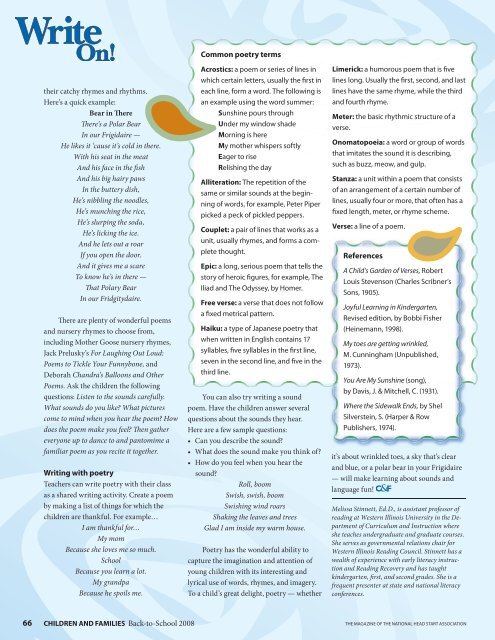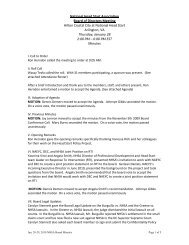New! - National Head Start Association
New! - National Head Start Association
New! - National Head Start Association
Create successful ePaper yourself
Turn your PDF publications into a flip-book with our unique Google optimized e-Paper software.
66<br />
their catchy rhymes and rhythms.<br />
Here’s a quick example:<br />
Bear in ere<br />
ere’s a Polar Bear<br />
In our Frigidaire —<br />
He likes it ‘cause it’s cold in there.<br />
With his seat in the meat<br />
And his face in the sh<br />
And his big hairy paws<br />
In the buttery dish,<br />
He’s nibbling the noodles,<br />
He’s munching the rice,<br />
He’s slurping the soda,<br />
He’s licking the ice.<br />
And he lets out a roar<br />
If you open the door.<br />
And it gives me a scare<br />
To know he’s in there —<br />
at Polary Bear<br />
In our Fridgitydaire.<br />
ere are plenty of wonderful poems<br />
and nursery rhymes to choose from,<br />
including Mother Goose nursery rhymes,<br />
Jack Prelusky’s For Laughing Out Loud:<br />
Poems to Tickle Your Funnybone, and<br />
Deborah Chandra’s Balloons and Other<br />
Poems. Ask the children the following<br />
questions: Listen to the sounds carefully.<br />
What sounds do you like? What pictures<br />
come to mind when you hear the poem? How<br />
does the poem make you feel? en gather<br />
everyone up to dance to and pantomime a<br />
familiar poem as you recite it together.<br />
Writing with poetry<br />
Teachers can write poetry with their class<br />
as a shared writing activity. Create a poem<br />
by making a list of things for which the<br />
children are thankful. For example…<br />
I am thankful for…<br />
My mom<br />
Because she loves me so much.<br />
School<br />
Because you learn a lot.<br />
My grandpa<br />
Because he spoils me.<br />
CHILDREN AND FAMILIES Back-to-School 2008<br />
Common poetry terms<br />
Acrostics: a poem or series of lines in<br />
which certain letters, usually the rst in<br />
each line, form a word. The following is<br />
an example using the word summer:<br />
Sunshine pours through<br />
Under my window shade<br />
Morning is here<br />
My mother whispers softly<br />
Eager to rise<br />
Relishing the day<br />
Alliteration: The repetition of the<br />
same or similar sounds at the beginning<br />
of words, for example, Peter Piper<br />
picked a peck of pickled peppers.<br />
Couplet: a pair of lines that works as a<br />
unit, usually rhymes, and forms a complete<br />
thought.<br />
Epic: a long, serious poem that tells the<br />
story of heroic gures, for example, The<br />
Iliad and The Odyssey, by Homer.<br />
Free verse: a verse that does not follow<br />
a xed metrical pattern.<br />
Haiku: a type of Japanese poetry that<br />
when written in English contains 17<br />
syllables, ve syllables in the rst line,<br />
seven in the second line, and ve in the<br />
third line.<br />
You can also try writing a sound<br />
poem. Have the children answer several<br />
questions about the sounds they hear.<br />
Here are a few sample questions:<br />
• Can you describe the sound?<br />
• What does the sound make you think of?<br />
• How do you feel when you hear the<br />
sound?<br />
Roll, boom<br />
Swish, swish, boom<br />
Swishing wind roars<br />
Shaking the leaves and trees<br />
Glad I am inside my warm house.<br />
Poetry has the wonderful ability to<br />
capture the imagination and attention of<br />
young children with its interesting and<br />
lyrical use of words, rhymes, and imagery.<br />
To a child’s great delight, poetry — whether<br />
Limerick: a humorous poem that is ve<br />
lines long. Usually the rst, second, and last<br />
lines have the same rhyme, while the third<br />
and fourth rhyme.<br />
Meter: the basic rhythmic structure of a<br />
verse.<br />
Onomatopoeia: a word or group of words<br />
that imitates the sound it is describing,<br />
such as buzz, meow, and gulp.<br />
Stanza: a unit within a poem that consists<br />
of an arrangement of a certain number of<br />
lines, usually four or more, that often has a<br />
xed length, meter, or rhyme scheme.<br />
Verse: a line of a poem.<br />
References<br />
A Child’s Garden of Verses, Robert<br />
Louis Stevenson (Charles Scribner’s<br />
Sons, 1905).<br />
Joyful Learning in Kindergarten,<br />
Revised edition, by Bobbi Fisher<br />
(Heinemann, 1998).<br />
My toes are getting wrinkled,<br />
M. Cunningham (Unpublished,<br />
1973).<br />
You Are My Sunshine (song),<br />
by Davis, J. & Mitchell, C. (1931).<br />
Where the Sidewalk Ends, by Shel<br />
Silverstein, S. (Harper & Row<br />
Publishers, 1974).<br />
it’s about wrinkled toes, a sky that’s clear<br />
and blue, or a polar bear in your Frigidaire<br />
— will make learning about sounds and<br />
language fun!<br />
Melissa Stinnett, Ed.D., is assistant professor of<br />
reading at Western Illinois University in the Department<br />
of Curriculum and Instruction where<br />
she teaches undergraduate and graduate courses.<br />
She serves as governmental relations chair for<br />
Western Illinois Reading Council. Stinnett has a<br />
wealth of experience with early literacy instruction<br />
and Reading Recovery and has taught<br />
kindergarten, rst, and second grades. She is a<br />
frequent presenter at state and national literacy<br />
conferences.<br />
THE MAGAZINE OF THE NATIONAL HEAD START ASSOCIATION




